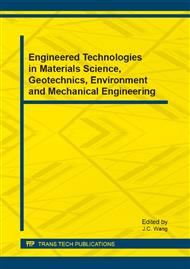[1]
Beake B. D., Bell G. A., Goodes S. R., et al. Improved nanomechanical test techniques for surface engineered materials. Surface Engineering, 2010, 26(1-2): 37-49.
DOI: 10.1179/174329409x451137
Google Scholar
[2]
Dearnley, P. A., Neville, A., Turner, S., et al. Coatings tribology drivers for high density plasma technologies. Surface Engineering, 2010, 26(1-2): 80-96.
DOI: 10.1179/174329409x451218
Google Scholar
[3]
R. Arvind Singh, Eui-Sung Yoon. Friction of chemically and topographically modified Si(100) surfaces. wear. 2007, 263: 912~919.
DOI: 10.1016/j.wear.2007.01.059
Google Scholar
[4]
Bharat Bhushan. Nanotribology and nanomechanics of MEMS/NEMS and BioMEMS/BioNEMS materials and devices. Microelectronic Engineering. 2007, 84: 387~412.
DOI: 10.1016/j.mee.2006.10.059
Google Scholar
[5]
Ashok Kumar, U. Ekanayake, J.S. Kapat. Characerization of pulsed laser-deposited diamond-like carbon films. Surface and Coating Technology, 102(1998): 113-118.
DOI: 10.1016/s0257-8972(97)00686-5
Google Scholar
[6]
M. Rubio-Roy, E. Pascual, M. C. Polo, et al. Structural and optical properties of diamond like thin films deposited by asymmetric bipolar pulased-DC reactive magnetron sputtering. Surf. Coat. Technol. 2008, 202: 2354-2357.
DOI: 10.1016/j.surfcoat.2007.08.044
Google Scholar
[7]
A. Czyzniewski. Preparation and characterization of a-C and a-C:H coatings depositied by pulsed magnetron sputtering. Surf. Coat. Technol. 2009,203: 1027-1033.
DOI: 10.1016/j.surfcoat.2008.09.027
Google Scholar
[8]
Y. Funada, K. Awazu, H. Yasui, et al. Adhension strength of DLC films on glass with mixing layer prepared by IBAD. Surf. Coat. Technol. 2000,128-129: 308-312.
DOI: 10.1016/s0257-8972(00)00591-0
Google Scholar
[9]
X. Yu, X. Zhang, C. B. Wang, et al. Structural, mechanical and frictional properties of tetrahedral amorphous carbon film by filtered cathodic vacuum arc system. Surf. Coat. Technol. 2007, 201:4995-4998.
DOI: 10.1016/j.surfcoat.2006.07.194
Google Scholar
[10]
Daniel Franta , David Nečas, Lenka Zajíčková, et al. Band structure of diamond-like carbon films assessed from optical measurements in wide spectral range. Diamond & Related Materials, 19(2010): 114-122.
DOI: 10.1016/j.diamond.2009.08.003
Google Scholar
[11]
Chen, C. P., Tan, A. H.. Wear corrosion properties of DLC films with different C(2)H(2) gas flows and CN layer of magnetic recording disks. Surface Engineering, 2009, 25(7): 496-501.
DOI: 10.1179/026708408x370212
Google Scholar
[12]
ZHANG Wei; ZHANG Shu; TANAKA Akihiro, et al. Friction and Wear Behavior of Diamond-like Carbon Multilayer Films in Different Environments. Tribology, 2006, 26(6): 510-515.(in Chinese)
Google Scholar
[13]
Chen, C. P., Tan, A. H.. Characterisation and microcorrosion of DLC ultrathin films with acetylene and ethylene source gases by PECVD. Surface Engineering, 2011, 27(3): 151-157.
DOI: 10.1179/174329409x409396
Google Scholar


